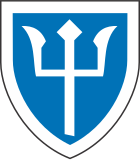97th Infantry Division (United States)
|
97th Infantry Division |
|
|---|---|
 Division badge |
|
| active | 1918, 1943 to 1946 |
| Country |
|
| Armed forces | United States Armed Forces |
| Armed forces | United States Army |
| Branch of service | infantry |
| Type | Infantry division |
| Strength | 14,600 |
| Butcher | Second World War |
| Commanders | |
| list of | Commanders |
The 97th Infantry Division ( German 97th US Infantry Division ) was a major unit of the US Army in World War I and World War II .
history
First World War
The division was officially set up in New Mexico on September 5, 1918 . The unit was supposed to be sent to Europe as part of the American Expeditionary Forces , but the division was no longer used due to numerous deaths from the Spanish flu and the end of the war in November 1918. It was demobelized again on November 20, 1918.
Second World War
On February 25, 1943, the division was reactivated and, after numerous training sessions in Texas and California , shipped to Europe on February 19, 1945. The unit had a strength of 14,600 soldiers. The division then came to Germany via France and the Netherlands as part of the Third Army , where it crossed the Rhine near Bonn at the beginning of April and then took part in the fighting at the Ruhr Basin. On April 12th, PFC Joe R. Hastings did so much in fighting at Drabenderhöhe that he was awarded the Medal of Honor posthumously.
On April 14th, soldiers of the division were able to liberate a POW camp near Much . On April 15, the division's soldiers liberated the Helmbrechts satellite camp . Two days later, on April 17th, the 97th Infantry Division marched into Solingen . Together with soldiers from the 90th US Infantry Division , units of the division liberated the Flossenbürg concentration camp on April 23 . Before that, military police from the 303rd Infantry Regiment are said to have encountered other soldiers on the camp grounds. The soldiers' soldiers helped with the care of the exhausted prisoners and the burial of the bodies. The division's intelligence service questioned some of the liberated prisoners in order to gather information about the SS guards. One of these soldiers in the division was the author Anthony Hecht .
On April 25, the division crossed the border to Czechoslovakia as part of the V Corps . Eger was one of the first places to be liberated. At the end of the war, parts of the division were still fighting on German territory near Weiden in the Upper Palatinate . In Czechoslovakia, the division's soldiers last stood at Konstantinsbad , where they finally saw the end of the war. Near Klenowitz in southern Bohemia the last exchange of fire of the Second World War is said to have taken place on the night of May 7, 1945, when soldiers of the 97th Infantry Division exchanged fire with a German sniper. The division set up its headquarters in Tachau for a short time before leaving the Czech Republic and handing the conquered area over to the Red Army .
A total of 188 soldiers of the 97th Infantry Division died in combat during the war, 721 were wounded and 9 are missing.
The division was brought to the United States on June 16, 1945 from Le Havre , France, and then sent to Japan, where it landed in Yokohama and served as an occupation force. The field of application lay in the Saitama Prefecture , the Gunma Prefecture , the Nagano Prefecture , the Niigata Prefecture , the prefecture of Fukushima and in the Tochigi Prefecture . Intelligence officers of the division secured Japanese stocks of radium and precious metals in Osaka and Iida . On March 31, 1946, the division was finally deactivated in Japan.
organization
When it was first established in 1918, the division had the following organization:
- Division headquarters
- 387th Infantry Regiment
- 388th Infantry Regiment
- 172nd Field Artillery Brigade
- 622nd Field Signal Battalion
- 366th Machine Gun Battalion
- 322nd Headquarters Train and Military Police
- 322nd Sanitary Train
During the deployment in Europe in 1945, the division had the following setup.
- 303rd Infantry Regiment
- 386th Infantry Regiment
- 387th Infantry Regiment
- 97th Reconnaissance Troop (Mechanized)
- 322d Engineer Combat Battalion
- 322d Medical Battalion
- 97th Division Artillery
- 97th Counter Intelligence Corps Detachment
- 797th Ordnance Light Maintenance Company
- 97th Quartermaster Company
- 97th Signal Company
- Military Police Platoon
- Headquarters Company
- tape
Division commanders
- Colonel CA Martin (September 26, 1918 - October 19, 1918)
- Brigadier General James R. Lindsay (October 19, 1918 - November 20, 1918)
- Major General Louis A. Craig (February 25, 1943 - January 19, 1944)
- Brigadier General Milton B. Halsey (January 20, 1944 - September 24, 1945)
- Major General Herman F. Kramer (September 24, 1945 - March 31, 1946)
Web links
Individual evidence
- ↑ Joe R. Hastings at Find A Grave
- ↑ Jonathan Post, The Selected Letters of Anthony Hecht. The Johns Hopkins University Press, Baltimore 2012, ISBN 978-1-4214-0730-2 . (English)
- ↑ 11 / North Tonawanda NY Evening News / North Tonawanda NY Evening News 1945 Grayscale / North Tonawanda NY Evening News 1945 Grayscale - 2385.pdf Press release on the service in Japan